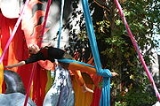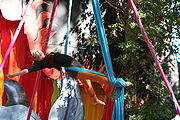
Silks
Encyclopedia
Aerial silk is a type of performance in which one or more artists perform aerial acrobatics
while hanging from a special fabric. Performers climbs the suspended fabric without the use of safety lines, and rely only on their training and skill to ensure safety. They use the fabric to wrap, suspend, fall, swing, and spiral their bodies into and out of various positions. Aerial silks may be used to fly through the air, striking poses and figures while flying. Some performers use dried or spray rosin
on their hands and feet to increase the friction and grip on the fabric.
, rolling or otherwise rotating oneself before landing in a new pose. Preparation for a drop can make for a pretty wrap, but the ultimate goal is the fall rather than the pose. Of the three trick types, drops require the most strength, and are also the most potentially dangerous. Rosin (dry or mixed with rubbing alcohol) is employed to help performers maintain their grip.
 The fabrics used as silks are very strong with some give and flexibility. The fabric is 2-way stretch polyester lycra. The width varies depending on the routine and the acrobat. The fabric is usually quite long, as it is doubled for rigging, giving the acrobat two strips of fabric to work with as he or she performs.
The fabrics used as silks are very strong with some give and flexibility. The fabric is 2-way stretch polyester lycra. The width varies depending on the routine and the acrobat. The fabric is usually quite long, as it is doubled for rigging, giving the acrobat two strips of fabric to work with as he or she performs.
applies to the hanging of aerial silks and hammocks. Aerial silk rigging equipment commonly includes:
Acrobatics
Acrobatics is the performance of extraordinary feats of balance, agility and motor coordination. It can be found in many of the performing arts, as well as many sports...
while hanging from a special fabric. Performers climbs the suspended fabric without the use of safety lines, and rely only on their training and skill to ensure safety. They use the fabric to wrap, suspend, fall, swing, and spiral their bodies into and out of various positions. Aerial silks may be used to fly through the air, striking poses and figures while flying. Some performers use dried or spray rosin
Rosin
.Rosin, also called colophony or Greek pitch , is a solid form of resin obtained from pines and some other plants, mostly conifers, produced by heating fresh liquid resin to vaporize the volatile liquid terpene components. It is semi-transparent and varies in color from yellow to black...
on their hands and feet to increase the friction and grip on the fabric.
Tricks
The three main categories of tricks are climbs, wraps and drops. Climbs employed by aerialists range from purely practical and efficient, such as the French climb, to athletic and elegant tricks of their own, such as the straddle climb. Wraps are static poses where aerialists wrap the silks around one or more parts of their body. In general, the more complicated the wrap, the stronger the force of friction and the less effort required to hold oneself up. Some wraps, such as the straddle-back-balance, actually allow performers to completely release their hands. Foot locks are a sub-category of wraps where the silks are wrapped around one or both feet. In a drop, performers wrap themselves up high on the silks before falling to a lower position. Drops can combine aspects of free fallFree fall
Free fall is any motion of a body where gravity is the only force acting upon it, at least initially. These conditions produce an inertial trajectory so long as gravity remains the only force. Since this definition does not specify velocity, it also applies to objects initially moving upward...
, rolling or otherwise rotating oneself before landing in a new pose. Preparation for a drop can make for a pretty wrap, but the ultimate goal is the fall rather than the pose. Of the three trick types, drops require the most strength, and are also the most potentially dangerous. Rosin (dry or mixed with rubbing alcohol) is employed to help performers maintain their grip.
Fabrics

- Stretch
- Low stretch fabrics. Low stretch fabrics are primarily used by beginners who have not yet developed proper climbing technique.
- Medium stretch fabrics. Medium stretch fabrics are the principle choice of professional aerialists and graduates of professional training programs such as École nationale de cirque.
- Width. Fabric width is mostly a personal choice. The thickness of the fabric when gathered is also influenced by the "denier", or technical thickness of the fabrics weave. 40 denier is a common choice. The following applies to 40 denier nylon fabric:
- 60" - Narrow when open, thin when gathered. Fairly common simply because the fabric is widely available.
- 72-84” - Average for adult performers
- 96" - Wide when open, thick when gathered. Best for adults with large hands.
- 108” - Very wide and thick. For adults with very large hands, or specialty acts.
- Length
- Length is a function of the height of the space available.
- For beginners, it is beneficial if the fabric comes down past the ground, allowing them to practice wraps at a lower level where they can be spotted.
- For intermediate users and above, it is sufficient if the fabrics to come down to the ground.
- For all users, the space required is usually between 20 and 30 ft. There are a great many tricks that can be done on a 12 to 15 ft (3.7 to 4.6 m) aerial fabric and a few drops require more than 30 feet, but for the most part 20 to 30 ft (6.1 to 9.1 m) is best.
Rigging
Aerial riggingAerial rigging
Aerial rigging is the process of setting up equipment used to make humans fly, specifically aerial circus equipment. The field is of critical importance, and a thorough grasp of the principles of rigging is essential....
applies to the hanging of aerial silks and hammocks. Aerial silk rigging equipment commonly includes:
- a figure-eight descender, rescue eight, ring, or other piece of hardware for holding the silk
- a ball-bearing swivel to keep the silk from twisting and to allow for spinning
- carabinerCarabinerA carabiner or karabiner is a metal loop with a sprung or screwed gate that is used to quickly and reversibly connect components in safety-critical systems. The word comes from "Karabinerhaken", meaning "hook for a carbine" in German.-Use:...
s for connecting the silk hardware to the swivel, and for connecting the swivel to a mounting point

